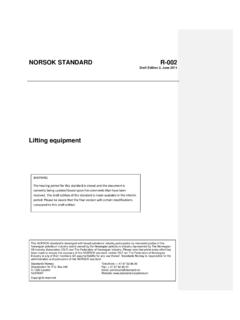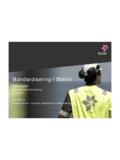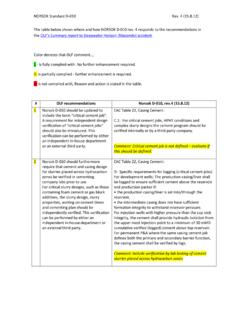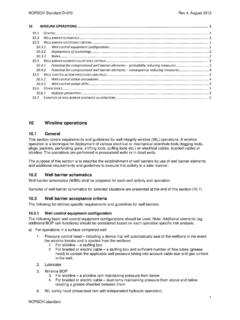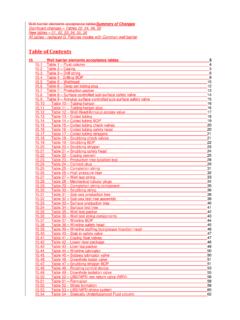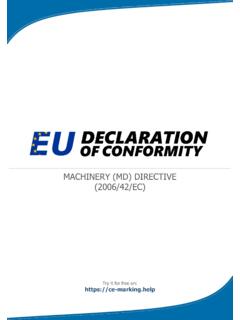Transcription of LIFTING EQUIPMENT OPERATION - Standard
1 NORSOK STANDARDLIFTING EQUIPMENT OPERATIONR-003 Rev. 1, October 1997 Please note that whilst every effort has been made to ensure the accuracy of the NORSOK standardsneither OLF nor TBL or any of their members will assume liability for any use EQUIPMENT OperationR-003 Rev. 1, October 1997 NORSOK standardPage 1 of 35 CONTENTSFOREWORD3 INTRODUCTION31 SCOPE42 NORMATIVE REFERENCES43 DEFINITIONS AND Abbreviations104 MANAGEMENT OF LIFTING Safe system of Control of the LIFTING Contractual Planning of the LIFTING Selection, responsibilities and minimum requirements for personnel115 SAFE USE OF LIFTING Requirements for documentation and Instruction Safe use156 INSPECTION, EXAMINATION AND Regular inspection Periodical control Inspection of LIFTING EQUIPMENT not in regular use Inspection at end of design life187 SAFE USE OF LIFTING Offshore Overhead travelling cranes/gantry Wireline SPM mounted offshore crane (maritimised lorry loading crane) Winches and Beam trolleys (permanently mounted)
2 Fixed load attachment Temporary BOP transporters228 SAFE USE OF LIFTING Chain Wire rope Fibre slings25 LIFTING EQUIPMENT OperationR-003 Rev. 1, October 1997 NORSOK standardPage 2 of Eyebolts and Wire Beam clamps and beam Snatch blocks and sheave Plate Offshore Personal protective EQUIPMENT against fall from heights28 ANNEX A: EXAMPLES OF LIFTING APPLIANCE AND LIFTING GEAR(INFORMATIVE)30 ANNEX B: EXAMPLE OF DECLARATION OF CONFORMITY AND CERTIFICATE OFAPPLICATION FOR LIFTING GEAR (INFORMATIVE)32 ANNEX C: SIGNALS AND COMMUNICATION FOR SAFE USE OF CRANES(NORMATIVE)34 LIFTING EQUIPMENT OperationR-003 Rev. 1, October 1997 NORSOK standardPage 3 of 35 FOREWORDNORSOK (The competitive standing of the Norwegian offshore sector) is the industry initiative toadd value, reduce cost and lead time and remove unnecessary activities in offshore fielddevelopments and NORSOK standards are developed by the Norwegian petroleum industry as a part of theNORSOK initiative and are jointly issued by OLF (The Norwegian Oil Industry Association) andTBL (Federation of Norwegian Engineering Industries).
3 NORSOK standards are administered byNTS (Norwegian Technology Standards Institution).The purpose of this industry Standard is to replace the individual oil company specifications for usein future petroleum industry developments and operations, subject to the individual company'sreview and NORSOK standards make extensive references to international standards. Where relevant, thecontents of this Standard will be used to provide input to the international standardisation to implementation into international standards, this NORSOK Standard will be A is B is C is primary purpose of this Standard is to provide owners and users of LIFTING EQUIPMENT on anoffshore installation with a framework and guidance to enable them to operate LIFTING EQUIPMENT in asafe and efficient manner. The purpose of this Standard is to focus on safe OPERATION of liftingequipment in order to establish, maintain and further develop an adequate level of safety forpersonnel, the environment and for physical assets during planning and execution of preparing this Standard , due considerations have been taken to Norwegian statutoryregulations, OLF guidelines, international and European standards and to operating companiesinternal specifications and procedures concerning the safe use of LIFTING appliances and LIFTING this NORSOK Standard gives information to many user groups special guidelines for thedifferent groups may need to be EQUIPMENT OperationR-003 Rev.
4 1, October 1997 NORSOK standardPage 4 of 351 SCOPEThis NORSOK Standard establishes requirements and guidelines for safe OPERATION of liftingequipment in the petroleum activities. It covers LIFTING appliances and LIFTING gear used in connectionwith LIFTING operations offshore. It does not cover drilling hoisting tools on the drill floor or in thedrilling derrick specifically designed and used for drilling operations or in the support of suchoperations, neither does it cover safe use of lifts, trucks and suspended scaffolding. Examples oflifting EQUIPMENT covered and not covered by this Standard are shown in annex covered include safe systems of work, , management, planning, OPERATION , selection,inspection/examination/testing and maintenance of LIFTING appliances and LIFTING gear as applicableas well as the requirements for competence of crane operators, slingers and NORMATIVE REFERENCESThe following regulations and standards include provisions which, through reference in this text,constitute provisions of this NORSOK Standard .
5 Latest issue of the references shall be used unlessotherwise agreed. Other recognised standards may be used provided it can be shown that they meetor exceed the requirements of the regulations and standards referenced an EN Standard or prEN Standard has been published covering the same field of applicationas a referenced ISO Standard , the EN or prEN Standard shall apply as provisions of this :Directorate for labourInspectionOrder no. 522 The Supply of Machinery (Safety) RegulationsOrder no. 523 Design of Protective EquipmentOrder no. 524 Minimum Health and Safety Requirements for theUse by Workers of Protective EQUIPMENT at theWorkplaceNorwegian PetroleumDirectorateYA-003 Regulations relating to systematic follow-up ofthe Working Environment in the PetroleumActivitiesEN Standards:Chain and Components:EN 818-1 Short Link Chain for LIFTING Purposes - Safety Part 1 : General Conditions of AcceptanceEN 818-2 Short Link Chain For LIFTING Purposes - Safety Part 2 : Medium Tolerance Chain for Chain Sling - Grade 8 LIFTING EQUIPMENT OperationR-003 Rev.
6 1, October 1997 NORSOK standardPage 5 of 35prEN 818-4 Short Link Chain for LIFTING Purposes - Safety Part 4 :Chain Slings - Grade 8prEN 818-6 Short Link Chain for LIFTING Purposes - Safety Part 6 : Chain Slings instruction for Use And 818-7 Short Link Chain for LIFTING Purposes - Safety Part 7 : Fine Tolerance Chainfor Serial Hoists, Grade T. Types T, DT, DAT)prEN 1677-1 Components for Slings - Safety. Forged Steel Components, Grade 12195-1 Load Restraint Assemblies - Safety - Calculation of ForcesprEN 12195-2 Load Restraint Assemblies - Safety - Web Lashing EQUIPMENT made of Man-made FibresFibre slings:pr. EN 1492-1 Textile slings - Safety - Part 1 : Specification for flat woven Webbing- slings made of Man-made EN 1492-2 Textile slings - Safety - Part 1 : Specification for Round-slings made of Man-made :pr EN 12937 Safety Of Machinery - Technical Principles and Specifications for Mobility and for Load 1050 Safety of Machinery - Risk Standards:ISO 7752-4 Cranes - Controls - Layout and Characteristics - Part 4: Jib 4302 Cranes - Wind Load AssessmentISO 8566-1 Cranes - Cabins - Part 1: GeneralISO 8566-5 Cranes Cabins - Part 5.
7 Overhead Travelling CranesISO 7752-1 LIFTING appliances - Controls- Layout - Characteristics - GeneralISO 10245-1 Cranes - Limiting and Indicating Devices - GeneralISO 9942-1 Cranes - Information Labels - GeneralISO 4310 Cranes - Test Code and ProceduresISO 4309 Wire Ropes - Code of Practice for Examination and DiscardISO/DIS 1461 Hot dip galvanised Coatings on Fabricated Ferrous 7531 Wire Rope Slings for general Purposes - Characteristics 2408 Steel Wire Ropes for general 8792 Wire Rope Sling - Safety Criteria and Inspection Procedures for 8793 Steel Wire Ropes - Ferrule secured Eye 12482-1 Condition Monitoring - GeneralISO/DIS 99277-1 Cranes Inspection - GeneralISO 9926-1 Training of Drivers. Part 1 - GeneralNorwegian Standards:Personal Protective EQUIPMENT against falls from heights:NS-EN 354 LanyardsNS-EN 358 Working Positioning SystemNS-EN 360 Retractable type Fall ArrestersNS-EN 361 Full Body HarnessLifting EQUIPMENT OperationR-003 Rev.
8 1, October 1997 NORSOK standardPage 6 of 35NS-EN 365 General Requirements for Instruction for Use and MarkingNS-EN 813 Sit harnessOthers:NS-1850 EyeboltsNS-1851 EyenutsNS-EN 292-1 Safety Of Machinery - Basic Concepts - General Principles for Design Part 1NS-EN 292-2 Safety Of Machinery - Basic Concepts - General Principles for Design Part 2 NORSOK Standard :R-002 LIFTING EquipmentDNV:DNV CN Offshore Freight Containers - Design and CertificationDNV CN Offshore Service Containers - Design and CertificationUS Federal Specifications:RR-C-271 CShackles. Type IV, Class 6FF-T-79-BTurnbucklesOLF Guideline:022:Recommended Guidelines for Safety Requirements of Hired EquipmentILO:152 Convention concerning Occupational Safety3 DEFINITIONS AND DefinitionsTerms and phrases within the scope of this Standard not defined herein shall be regarded as definedin the regulations and international codes and standards referred to in this visual and functional assessment (not a test) of the condition of the crane without checkerMeans a person in an enterprise of competence who has sufficient theoretical knowledge, practicalexperience and understanding of the LIFTING EQUIPMENT required to carry out the personMeans a person in an enterprise of competence who has sufficient theoretical knowledge andpractical experience to understand the LIFTING EQUIPMENT design, its function, to performcalculations, examinations and testing as required and to issue a certificate of application and othercertificates prescribed by the EQUIPMENT OperationR-003 Rev.
9 1, October 1997 NORSOK standardPage 7 of 35 Detachable LIFTING equipmentRemovable below hook EQUIPMENT for LIFTING appliances providing a link between the liftingappliance and the load being lifted and are detachable and easy to separate from the LIFTING appliancewithout disassembly. Examples of detachable LIFTING EQUIPMENT are shown in annex goodsGoods classified and labelled according to the IMDG of competenceUnit within the operating companies organisation, another company or institution with adequatecompetence (theoretical knowledge and practical experience) to understand the design, calculationsand OPERATION of LIFTING EQUIPMENT and with the ability to carry out the necessary examinations andtests and issue the prescribed that the crane can safely continue in service including a functional test of all safetydevices limiting, indicating EQUIPMENT , brakes, clutches etc.
10 To verify that they operate within therequired tolerances. An examination is more thorough than an load attachment pointsFixed load attachment points are padeyes, LIFTING beams, foundation for winches, "buckets" forwireline cranes and beams for use of beam at the crane for defects and checking the OPERATION of the controls, limiting and indicatingdevices without loading the crane. This is much more than a casual glance but does not normallyrequire any part of the crane to be applianceMachine or appliance used for the purpose of LIFTING goods and materials, or in special casespersonnel. Examples of LIFTING appliances are given in Annex componentsLifting components are elements not attached to the LIFTING appliance and placed between the liftingappliance and the load or on the load in order to attach equipmentThe term LIFTING EQUIPMENT is used in this Standard as a common expression for LIFTING appliances , LIFTING gear and LIFTING components used together or of LIFTING EQUIPMENT are given in Annex gearLifting gear means chain, shackles, rings, hooks, swivels, drum fasteners, steel plate clips, blocks,loading pallets and chain, wire or rope slings etc.

